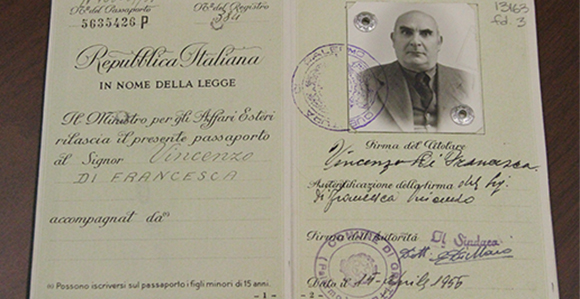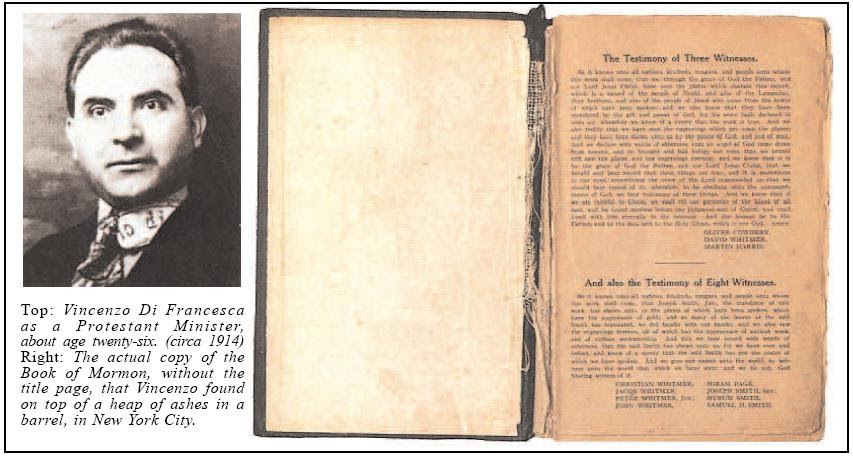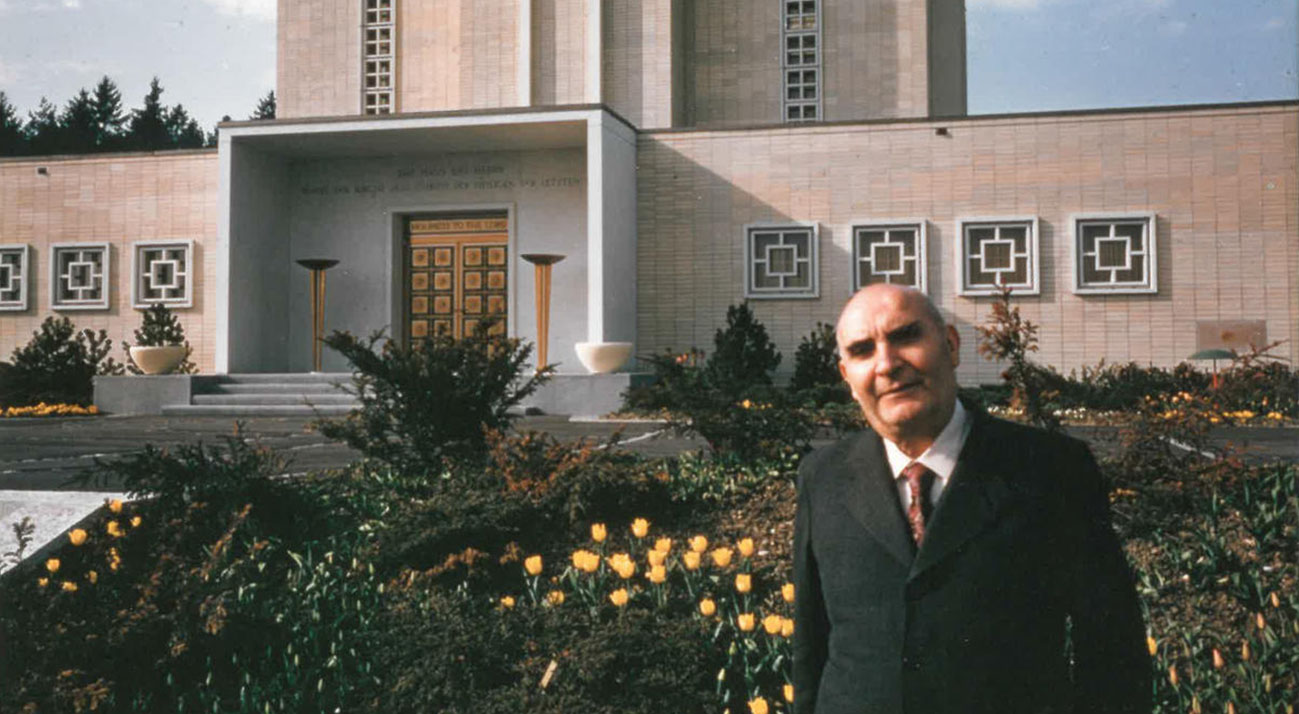Your basket is currently empty!
VINCENZO DI FRANCESCA’S INCREDIBLE STORY, PIONEER OF THE MORMON CHURCH
The incredible story of an emigrant in New York from gratteri, who is a pioneer of the Mormons’ Church
The incredible history of an emigrants from Gratteri to New York, who is a pioneer of the Mormon church
This is the story of a boy from Gratteri, Vincenzo Di Francesca, who emigrated to America in 1907 when he was only 17 years old, who- thanks to the discovery of a book on a barrel of ashes in New York in 1910- was considered one of the most important pioneers of the birth of the church of “Gesù Cristo dei Santi degli ultimi giorni” (Jesus Christ of Latter-day Saints), commonly known as the Mormon Church, which currently includes more than 16 milions members worldwide.
Vincenzo Di Francesca was born on September 23 1888, he studied religion until 1905. That year, his brother Antonino, who lived in New York, invited him to attend a seminary in America, only to become a pastor in Brandi’s Italian chapel:
“ My parents were Giuseppe Di Francesca and Marianna Di Maria, both born in this city (Gratteri) and married at a young age. My mother died on February 23, 1983, leaving her children Giuseppina, Antonio, Vincenzo orphaned, and we remained in the care of their parents, Maria e Antonio Di Maria. On October 20, 1893 my father married again with Giovanna Giallombardo and from this marriage two children were born, Sara and Giacomo.
On September 26, 1895, I started attending the first elementary class, State School, and so in the year 1896 the second class, 1897 the third class, 1898 the fourth class and in 1899 the firth class. During these days after school my grandfather Antonino wanted me to receive private lessons of religion from a Salesian teacher, his cousin Vincenzo Serio, who explained to me how to read the Ols and the New Testament with emphasis; I was so successful in these lessons that in the end he promoted me with these words: “You are blessed!”.
On November 3, 1900 I was admitted to the first class of the Gymnasium in the Laic-Clerical Gymnasium of the city of Cefalù, where I studied religion until July 2, 1905. On September 20, 1905 my brother Antonino, who was living in the city of New York, invited me to spend the holidays from the Seminary with him and I, at about 17 years old, got a second class place on the Steam “City of Naples” and landed in the port of New York on October 12, 1905.
The first day I made friends with a friend of my brother’s, a Methodist Pastor of Brandi’s Italian Chapel named Ariel Dibellon. I soon became a teacher in that congregation and the Venerable proposed to me to attend the Evangelical Course on both the Old and New Testament at Knox College in New York, where I obtained the Pastor’s diploma, with great honour, on November 24, 1909″. […].
A letter, written by Vincenzo Di Francesca to Leavitt Christensen, President of the Italian District of the Swiss Mission. Transcription and Preface by Dan Knudsen – Translation and Introduction by Renato Marini).
In the story published in “Ensign”, Vincenzo Di Francesca explained that on a cold February morning in 1910, while he was walking along the streets of Broadway, he saw a book lying on a barrel covered with ashes, whose pages were moved by the strong wind of the open sea. He picked up the book and slammed it against the barrell to remove the ashes. He noticed that it had been printed in English but the frontispiece had been torn off.
“In February 1910, on a very cold morning in the first half of the month, the caretaker of the Italian Chapel brought me a note from my colleague Anziano Scarillo, in which he informed me that he was in bed, ill with the flu, and begged me to go to his home, at the end of Fifth Avenue, to receive instructions about an urgent practice of the Prothonotaries, and instruct them.
So I did, and while I was walking on the right pavement of Broadway, towards the New York Battery, and exactly in front of the door of the “House of the Mariner” (The Sailor’s House) where the Singer Machine Company’s skyscraper now stands, the strong breeze of the Wind of the Sea coming from the open sea moved the pages of something that looked like a book thrown on a barrel full of ashes, ready to be buried in the Town Hall rubbish truck.
The size of the pages and the shape of the back on which they were bound gave me the idea that it was a religious book and curiosity drove me to come closer to see that I could read the stamp. As soon as I looked at it I realized it was a religious book and I picked it up and banged it against the edge of the bin. I looked for the frontispiece but saw that it had been torn off.
The fury of the wind made the pages turn in my hands, and I could hastily read Alma, Mosia, Mormon, Moroni, Isaiah, Lamanita, names I had never heard of in my life and, both for the hurry to go on, and for the cold that froze my face, I wrapped that dirty book in the newspaper that I had bought at the Central Post Office building, and I continued on my way to the house of my colleague Scavillo. […]
The reading of those pages left in my memory like a strong magnet that attracted me to read, again and again, and I was impressed that I had before me the Gospel of the Meridian of Times, and I thought it very appropriate to say that it was the fifth Gospel of the Redeemer”.
After receiving the spiritual experience from reading the verse in Moroni, he continued his service in the parish, until, censored by a parish committee, he was ordered to burn the book. However, he refused to do so and in November 1914 he was called into the Italian army and sent to France.
“On November 27, 1914, the Italian Consulate in New York called me to arms along with my class of conscript 1888, and I embarked for Italy on the “Earl White Hand” steamer, I landed in the port of Naples and was incorporated into the 127th Infantry Regiment in the city of Florence, as a private, and effective at the 10th company; then I passed to the Command Company.
On May 24, 1915 I was put in mobility and was sent to the front of the combat operations, in the trenches, in Pava, Zagora and Zagoni, and I followed all the madness of the attacks, day and night, of the Regiment, experiencing hours of danger of death, and all sorts of sufferings of war, in the trenches and in the field.
On August 5, 1916 I was denounced by the Roman Apostolic Chaplain of the Regiment to the Colonel Commander for defeatism, as I had told the story of the people of Ammon who refused to fight and buried their weapons as evidence that they would never use them again, and if the Lamanites went against the Lamanites who refused to take up arms and destroyed them, they would go to God and be saved.
At the end of the war he returned to New York, where he was admitted to his former congregation as lay member. He was sent to Australia, where, preaching to some Italian immigrants, he taught again from the Book of Mormon, still not knowing the name of the book. It was brought back to the synod and cut off again from the church. In May 1930, while he was looking for something in a French dictionary, saw the entry “Mormon”.
From that moment, he found enough information to write to the Brigham president Young University in Provo, Utah. Her letter was sent to the President of the Church Heber J. Grant. They were later sent to him with some information and finally managed to learn more about the Church of Jesus Christ of Latter-day Saints. In 1956, received his endowment in the Swiss temple in Bern.
Vincenzo Di Francesca never got married. He returned to Sicily where he lived until his death with his sister in Gratteri, who organized a Catholic funeral for him, then picked up his personal effects and gave them to the missionaries of the Church of Jesus Christ, who had passed them to the mission president. Some of these, including what is supposed, the copy of the Book of Mormon which he found in 1910 in New York City, were transmitted to the archives of the Salt Lake City Church.
Millions of Latter-day Saints have come closer to the extraordinary story of conversion of Vincenzo Di Francesca through the film commissioned by the Church in 1987: “How Rare a Possession: The Book of Mormon”.

In the story published in “Ensign”, Vincenzo Di Francesca explained that on a cold February morning in 1910, while he was walking along the streets of Broadway, he saw a book lying on a barrel covered with ashes, whose pages were moved by the strong wind of the open sea. He picked up the book and slammed it against the barrell to remove the ashes. He noticed that it had been printed in English but the frontispiece had been torn off.
“In February 1910, on a very cold morning in the first half of the month, the caretaker of the Italian Chapel brought me a note from my colleague Anziano Scarillo, in which he informed me that he was in bed, ill with the flu, and begged me to go to his home, at the end of Fifth Avenue, to receive instructions about an urgent practice of the Protonotaries, and instruct them.
So I did, and while I was walking on the right pavement of Broadway, towards the New York Battery, and exactly in front of the door of the “House of the Mariner” (The Sailor’s House) where the Singer Machine Company’s skyscraper now stands, the strong breeze of the Wind of the Sea coming from the open sea moved the pages of something that looked like a book thrown on a barrel full of ashes, ready to be buried in the Town Hall rubbish truck.
The size of the pages and the shape of the back on which they were bound gave me the idea that it was a religious book and curiosity drove me to come closer to see that I could read the stamp. As soon as I looked at it I realized it was a religious book and I picked it up and banged it against the edge of the bin. I looked for the frontispiece but saw that it had been torn off.
The fury of the wind made the pages turn in my hands, and I could hastily read Alma, Mosia, Mormon, Moroni, Isaiah, Lamanita, names I had never heard of in my life and, both for the hurry to go on, and for the cold that froze my face, I wrapped that dirty book in the newspaper that I had bought at the Central Post Office building, and I continued on my way to the house of my colleague Scavillo. […]
The reading of those pages left in my memory like a strong magnet that attracted me to read and reread, again and again, and I was impressed that I had before me the Gospel of the Meridian of Times, and I thought it very appropriate to say that it was the fifth Gospel of the Redeemer”.
After receiving the spiritual experience from reading the verse in Moroni, he continued his service in the parish, until, censored by a parish committee, he was ordered to burn the book. However, he refused to do so and in November 1914 he was called into the Italian army and sent to France.
“On November 27, 1914, the Italian Consulate in New York called me to arms along with my class of conscript 1888, and I embarked for Italy on the “Earl White Hand” steamer, I landed in the port of Naples and was incorporated into the 127th Infantry Regiment in the city of Florence, as a private, and effective at the 10th company; then I passed to the Command Company.
On May 24, 1915 I was put in mobility and was sent to the front of the combat operations, in the trenches, in Pava, Zagora and Zagoni, and I followed all the madness of the attacks, day and night, of the Regiment, experiencing hours of danger of death, and all sorts of sufferings of war, in the trenches and in the field.
On August 5, 1916 I was denounced by the Roman Apostolic Chaplain of the Regiment to the Colonel Commander for defeatism, as I had told the story of the people of Ammon who refused to fight and buried their weapons as evidence that they would never use them again, and if the Lamanites went against the Lamanites who refused to take up arms and destroyed them, they would go to God and be saved. “
At the end of the war he returned to New York, where was admitted to his former congregation as lay member. He was sent to Australia, where, preaching to some Italian immigrants, taught again from the Book of Mormon, still not knowing the name of the book. It was brought back to the synod and cut off again from the church. In May 1930, while he was looking for something in a French dictionary, saw the entry “Mormon”.
From that moment, he found enough information to write to the Brigham president Young University in Provo, Utah. Her letter was sent to the President of the Church Heber J. Grant. They were later sent to him some information and finally managed to learn more about the Church of Jesus Christ of Latter-day Saints. In 1956, received his endowment in the Swiss temple in Bern.

Vincenzo Di Francesca never married. He returned to Sicily where he lived until his death with his sister in Gratteri, who organized a Catholic funeral for him, then picked him up personal effects and gave them to the missionaries of the Church of Jesus Christ, who have passed them to mission president. Some of these, including what is supposed, the copy of the Book of Mormon which he found in 1910 in New York City, were transmitted to the archives of the Salt Lake City Church.
Millions of Latter-day Saints have come get closer to the extraordinary story of conversion of Vincenzo Di Francesca through the film commissioned by the Church in 1987: “How Rare a Possession: The Book of Mormon”.
Marco Fragale
(Università di Palermo)
Bibliografia:
This information is taken from “Bella Sion / Biografie La storia di Don Vincenzo Di Francesca, 2003 (www.bellasion.org) and from another article originally written by Scott Proctor and published on ldsmag.com, translated by Nadia Manzaro. Above: Vincenzo Di Francesca, Protestant minister, at the age of 26 (about 1914). Right: The copy of the Book of Mormon, without the title page, that Vincenzo found on a barrel of ashes in New (www.bellasion.org).



